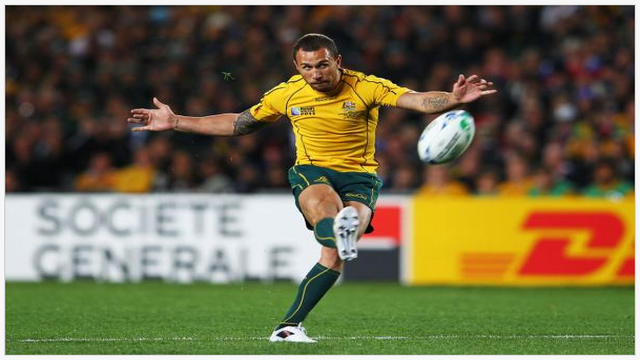The recent Bledisloe Cup double-header saw the All Blacks come out on top in many areas of the games, most importantly on the scoreboard. Steve Hansen’s men carried out the basic attacking skills with excellence, their defence was solid and they performed well in the scrum and out of touch. Another area where the All Blacks came out as clear winners was at the restarts.
It’s worth taking a detailed look at exactly what both teams did with their restarts. Since 1962, the Bledisloe Cup has seen only a single game where one of the teams failed to score (22-0 to the All Blacks in 2012). With that in mind, and the fact that these fixtures are generally quite high scoring, it seems obvious that both coaches would have included a restart strategy in training during the build up. A ‘restart strategy’ may sound complicated but it needn’t be. Essentially you’re aiming to win the ball back, force the opposition into mistakes or pressure them into returning possession to one of your strengths. Over the course of the two Bledisloe Cup games, New Zealand were more effective in achieving those goals. While Australia did some good work from restarts, they could have been far more potent with a few simple changes.
In recent years, the All Blacks have been particularly successful at winning possession back from their restarts. Dan Carter is excellent at placing low-trajectory drop kicks just over the 10-metre line, where it’s usually Kieran Read who attempts to re-gather them at head height. In the first Bledisloe Cup game, that is exactly what the All Blacks aimed to do with their first four restarts. While Read did manage to claim one of them, Aaron Cruden’s relatively poor drop kicking let them down, with one effort going directly into touch and another dropping short of the 10-metre line.
That tactic wasn’t working, so the All Blacks changed their approach. Having gone 12-10 down, Cruden kicked the next restart deeper to the right, just in front of the Australian 22-metre line. The Wallabies immediately looked uncertain of how they should kick out of their own territory, and a phase later Leali’ifano was blocked down for Cruden’s try. Weakness identified. New Zealand had two more restarts in the game, and both went to precisely the same zone as for that block down. The Wallabies cleared their lines on both occasions but it’s worth noting how ill at ease they looked in doing so. In the second game, the All Blacks had five restarts in total (including the kick-off) and went for that same zone, wide on the right of the 22-metre line, every single time.They managed to get blocks or partial blocks on three of the Wallabies’ attempts to kick out of their territory. While none of them led directly to scores, it heaped pressure on Australia and showed that New Zealand had a clear and effective restart strategy. They identified a weakness and went after it ruthlessly.
The same can’t be said for Australia. They did pinpoint a genuine strength of their own at the restart but just didn’t pursue it with the same conviction. In Israel Folau, the Wallabies possess one of the best kick catchers in the world. Restarts are an ideal opportunity to utilise his height, explosive leap and ability to field kicks overhead. In the first game, the Wallabies had nine restarts but only three times was Folau the target, and just one of them was intelligently conceived. Matt Toomua did try three short restarts in the first 40 minutes or so, but the chasers were Adam Ashley-Cooper and Hugh McMeniman. While both those guys can jump and compete, they are not in Folau’s league.
Only after going 37-22 down did the Wallabies start sending Folau after their restarts. The first one was long, landing over Read, who is excellent in the air. Why kick to one of the All Blacks’ strengths? The No. 8 fielded the restart under pressure from Folau. The second time, substitute Quade Cooper’s kick didn’t reach the 10-metre line. Only on the third occasion were Australia successful. Folau moved over to the left-hand side of the pitch, Cooper dropped a high, hanging kick over Steven Luatua and Folau tapped it back on the Wallabies’ side to regain possession. It was the 73rd minute of the game, but Ewen McKenzie’s team had finally discovered a successful formula. Surely we would see that very tactic remorselessly employed in the second match a week later.
Not so. The Wallabies first four restarts went medium to long range, with no sign of Folau underneath them. Only after going 18-6 down did the Wallabies decide to ‘risk’ putting their restarts short for Folau to compete. The first time, a superb overhead catch from Richie McCaw denied the gigantic winger but on the other two occasions, Folau regained possession for Australia under short, high Cooper drop kicks.It’s easier said than done, but the Wallabies need to get Folau involved in the game more often. Pursuing the successful restart tactic would have been a simple and effective way of doing that. Admittedly there are clear risks in attempting to win possession back from the majority of restarts. However, with the Wallabies struggling to create attacking chances, an ambitious restart strategy could have unsettled and disorientated the New Zealand defence.
The All Blacks looked uncomfortable going up against Folau in the air, so why didn’t the Wallabies pursue that strength as clinically as the All Blacks exposed the Wallabies discomfort at kicking out of their own 22? It’s worth noting that not a single one of the All Blacks’ 12 restarts over the course of the two games went to the left-hand side of the pitch, where Folau dwells.
Steve Hansen and his coaching team clearly recognised and planned around the Wallabies’ greatest strength, but has McKenzie done the same?


